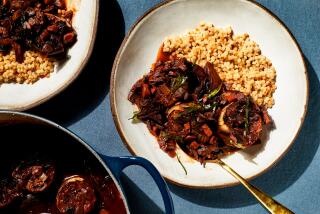The Essence of Bouillabaisse
- Share via
Making traditional bouillabaisse is a long and painstaking endeavor involving at least nine kinds of Mediterranean fish. You can capture the rich flavor of this dish from the South of France in a fraction of the time by steaming sweet Manila clams, which are the best part of the bouillabaisse anyway, with tomatoes, garlic, saffron and a splash of Pernod.
There are many versions of rouille, the garlicky rust-colored mayonnaise that traditionally garnishes bouillabaisse. This one gets its spice and color from tomatoes and cayenne pepper.
Serve clams in bowls with thick slices of garlic toast to soak up their juices and a dollop of rouille on the side. For dessert, mix sliced fresh peaches and raspberries.
*
Menu / 30 MINUTES OR LESS
Clams Marseilles
With Toast and Rouille
Peaches and Raspberries
Countdown
30 minutes before: Chop garlic and parsley. Slice bread.
25 minutes before: Make rouille.
15 minutes before: Begin cooking clams.
5 minutes before: Toast bread.
After main course: Slice peaches and serve with raspberries.
Shopping List
1 loaf crusty bread
1 1/2 pounds clams
1 (8-ounce) bottle clam juice
1 bunch parsley
2 peaches
1/2 pint raspberries
1 ounce saffron threads
3/4 pound tomatoes
Staples
Cayenne pepper
Eggs
Garlic
Lemon
Olive oil
Pepper
Pernod or other anise-flavored liquor
Salt
1 (4-ounce) can or tube tomato paste
White wine
*
CLAMS MARSEILLES
1 1/2 pounds clams
1/4 cup olive oil
3 tablespoons minced garlic
1 cup peeled and chopped tomatoes
1/8 teaspoon crumbled saffron threads
1/2 cup dry white wine
2 teaspoons Pernod or other anise-flavored liquor
3/4 cup clam juice
1/4 cup chopped parsley
Pepper
4 thick slices crusty bread
Wash clams thoroughly under cold running water. Discard any that are broken or open. Set aside.
Heat 2 tablespoons olive oil in skillet and add 2 tablespoons garlic. Cook about 1 minute and add tomatoes. Cook 2 to 3 minutes more. Add saffron, wine, Pernod and clam juice and bring to boil. Add clams. Cover and cook over high heat until clams open, about 5 minutes. Remove skillet from heat and add parsley. Season to taste with pepper.
Mix remaining 1 tablespoon garlic with remaining 2 tablespoons olive oil and brush on bread slices. Toast under broiler until golden.
Place 1 piece garlic toast in each bowl. Remove clams from liquid and divide between bowls. Pour broth over and serve with remaining garlic toast and Rouille on the side.
2 servings. Each serving without Rouille:
638 calories; 699 mg sodium; 53 mg cholesterol; 31 grams fat; 53 grams carbohydrates; 27 grams protein; 1.04 grams fiber.
ROUILLE
1 egg yolk
1/2 cup olive oil
1/4 teaspoon cayenne pepper
1 teaspoon lemon juice
2 teaspoons minced garlic
2 tablespoons tomato paste
Salt, pepper
Rouille can be made in a food processor. Keep it running as you add the oil. This recipe contains raw eggs; see Safety Tips.
Rinse large bowl under hot water to warm.
Whisk yolk in warmed bowl until broken up. Gradually add oil to yolk, whisking vigorously. (Note: If oil is added too quickly, mixture will not emulsify into thick sauce. If mixture becomes thicker than mayonnaise before all oil is added, whisk in few drops warm water to thin before adding more oil.)
When mixture is thickened to consistency of mayonnaise, add cayenne, lemon juice, garlic and tomato paste and whisk to combine. Season to taste with salt and pepper.
Makes about 3/4 cup. Each 2-tablespoon serving:
176 calories; 54 mg sodium; 45 mg cholesterol; 19 grams fat; 1 gram carbohydrates; 1 gram protein; 0.09 gram fiber.
(BEGIN TEXT OF INFOBOX / INFOGRAPHIC)
CHEF’S TIPS:
* Remove clams from plastic bag. Discard any with broken shells or that are open and don’t shut when tapped. Place clams in bowl without water. Cover with paper towel and refrigerate. Do not keep clams more than 1 day before using.
* Buy tomato paste in a tube so that you can use only what you need and refrigerate the rest.
* Room temperature or warm egg yolks will emulsify better than cold ones.
Safety Tip
When raw eggs are called for in a recipe, there are a couple of methods a cook can use to make the eggs safer. The Food Section is working on a special section on Food Safety to be published in September; in the meantime, here are two methods The Times Test Kitchen uses to heat egg yolks before using them in recipes that traditionally use raw yolks.
Microwave Method: Heat egg yolks on HIGH 30 seconds. Now heat the egg yolks on HIGH at 10-second intervals, up to 60 seconds total cooking time, watching through window to see if yolks begin to move. As soon as movement is detected in yolks, heat on HIGH 8 to 10 seconds more. Beat yolks until smooth with clean fork or whisk. Return to microwave and heat on HIGH until yolks again begin to move, up to 10 seconds. Remove yolks from microwave, cover and let stand 1 minute. If using extra-large eggs, stir in 2 tablespoons plus 1 teaspoon water before microwaving.
Stove-top Method: Heat 2 egg yolks over very low heat in saucepan with 1/4 cup of the most acidic liquid called for in the recipe. The acidity in vinegars and lemon or lime juice helps prevent the yolks from curdling. Stir the yolks constantly until they thicken like lemon curd, 3 to 4 minutes. If using cooking thermometer, check that yolks are heated to 160 degrees or to 140 for 3 1/2 minutes.
More to Read
Eat your way across L.A.
Get our weekly Tasting Notes newsletter for reviews, news and more.
You may occasionally receive promotional content from the Los Angeles Times.










